 |
|
| Newsletter No.1 | 28 January, 2002 |
|
Welcome to our first Newsletter:
|
|
Many thanks to all of you who have visited our infant website and taken the trouble to subscribe to our Newsletter. We have had a great reception so far, and some very kind comments, which more than compensate for all those long hours getting it ready, to say nothing of the fifteen years Gary spent researching the subject beforehand. It just goes to show what a bit of solid determination can do.
As I said, the initial reception has been very good, but we have already earmarked areas for improvement. The Bibliography has been re-written, it now contains references to over 200 texts, almost all of which |
have been used in the research for our website.
Thanks again for visiting us and do send us an email if you would like to comment on our website or if you have anything to add to our research. And please don't forget to let all your friends know. See you on the website! Tim Gardner
| top |
|
New biographies during January:
|
| Boschetti (fl. 19th Century). Little seems to be known about this Italian sculptor. We tell the story of, apparently, his only recorded public work in Britain La Innocenza (trans: The Innocent Girl). | top |
| Peddie & Kinnear (fl. 1848-94). This is a four-in-one biography of the architectural firm and its three partners. Hugely prolific, they received commissions for buildings of every type throughout Scotland and designed in all the fashionable styles. They also designed some of the most elegant Classical churches in Glasgow. | top |
| William Stark (1770-1814). Stark was born in Dunfermline, Fife and had a great influence on the development of the Classical revival in Scotland. Amongst his works of note are St George's Tron Church, Buchanan Street (1809) and the Lunatic Asylum (1809, dem. 1910). | top |
|
New photo galleries during January:
|
 Anderston Savings Bank. One of the finest and most delicately ornamented Glasgow-Style buildings in the city, it was erected by the Glasgow Savings Bank in 1899-1900, as their Anderston Branch.
Anderston Savings Bank. One of the finest and most delicately ornamented Glasgow-Style buildings in the city, it was erected by the Glasgow Savings Bank in 1899-1900, as their Anderston Branch.
The sculptor was Albert Hodge (1875-1917).
| top |
 Kelvin Way Bridge. Set amidst some of the most spectacular urban scenery in Britain, the bridge was designed in 1912 and spans the River Kelvin in Kelvingrove Park. Montford's sculpture groups were selected in a competition in 1914 and were finally completed in 1926.
Kelvin Way Bridge. Set amidst some of the most spectacular urban scenery in Britain, the bridge was designed in 1912 and spans the River Kelvin in Kelvingrove Park. Montford's sculpture groups were selected in a competition in 1914 and were finally completed in 1926.
The sculptor was Paul Raphael Montford (1868-1938).
| top |
 Shona Kinloch Glasgow Gallery. This is a set of photographs showing some of Shona Kinloch's work in Glasgow, including In Pursuit of..., Thinking of Bella, As the Crow Flies and As Proud As....
Shona Kinloch Glasgow Gallery. This is a set of photographs showing some of Shona Kinloch's work in Glasgow, including In Pursuit of..., Thinking of Bella, As the Crow Flies and As Proud As....
There are others, such as the Chookie Burdies, on lampposts in Garnethill, which we still have to add. | top |
|
Recommend us to a friend:
|
| Please forward this newsletter on to any of your friends or colleagues who you feel may be even remotely interested in Glasgow or Sculpture. Even if they aren't now, I'm sure they soon will be. | top |
|
Glasgow News:
|
|
David Mach, the Fife-born sculptor, now living in London, is returning to Glasgow to stage a solo show at the Gallery of Modern Art. His works are usually on a colossal scale, so we never know quite what to expect. This show, though, is a photograph project and requires all Glaswegians, wherever they may be, to donate their photographs. He wants action-packed snapshots of ordinary Glaswegians to help him make four giant collages of the city, which will then join the permanent collection in the gallery. You can donate your photographs by dropping them off at any Glasgow Museum or sending them to: David Mach Exhibition, Gallery of Modern Art, Queen Street, Glasgow G1 3AZ. Photographs cannot be returned and their use is not guaranteed. The exhibition will run from March 22 to September 29. Source: The Herald, 07 January, 2002. | top |
|
Inside Story:
Robert Burns in Glasgow.
Glasgow had missed a golden opportunity to 'discover' Burns in 1786 when the city's publishers declined to publish his Cottar's Saturday Night, but can at least claim to have encouraged him to stay in Scotland and seek an Edinburgh publisher. In the event, it was during his journey home that he found his first publisher, John Wilson, who produced the famous Kilmarnock Edition which made his name. Burns was a frequent visitor to Glasgow and stayed at the Black Bull Hotel in Argyle Street (later Mann Byars), and it was from here that he wrote love letters to Agnes McLehose, whom he wooed as Clarinda to his Sylvander, and who lived in a house in St. Andrew's Square.
In the 19th Century, Glasgow's sculptors regularly worked on commissions involving portraits of Burns, including marble busts, architectural sculpture and public monuments. John Mossman was particularly noted for his contribution of a number of Burns portraits to Glasgow's buildings. His bust of Burns representing Poetry can be seen on the Queen's Rooms (now Hindu Mandir), 1 La Belle Place, where it is part of a great sculpture scheme devised by architect Charles Wilson to depict the rise of civilization and the development of the arts. Burns takes his place on the west front in a gallery of portrait busts of other important artists and men of letters (1854-7).
Photographs of the statue being lowered from the attic ballustrade of the Citizens Theatre appeared in the press at the time, including the Glasgow Herald, on 12 July 1977 (pp. 6, 8); 15 July 1977 (p. 15); and 14 September 1979 (p. 6). Another Glasgow sculptor fond of Burns was William Kellock Brown, who competed in the Paisley Burns Monument competition of 1893, but without success. His magnificent model for the competition, of Burns standing on a tall, architectural pedestal, was published in the architectural press after F.W. Pomeroy had been announced as the competition's winner. Other Burns portraits by Kellock Brown include The Thresher, a large-scale, bronze statue on display in Kelvingrove Art Gallery and Museum. The sculptor was also said to have been working on a 'Colossal' (unlocated) statue of Burns at the time of his death, in 1934.
Another lost portrait is the plaster statue of Burns which was modelled by Scott Sutherland for the Scotland Pavilion at the Empire Exhibition held in Bellahouston Park in 1938. This was lost, together with statues of other great Scots, when the building was demolished soon after the exhibition closed.
Ewing's statue ranks amongst the best depictions of the poet in a standing, contemplative pose, and for the accuracy and treatment of its portrait and costume. His depiction of Burns as a 'superior Scottish peasant' holding the 'wee crimson-tipped flower', which inspired one of his best loved poems, won both public and official acclaim on its unveiling on 25th January 1877, but this was too late to prevent Ewing's reputation being severely dented by the earler bad publicity, or to stop him from departing for America soon afterwards, leaving his brother James Alexander Ewing, to provide the statue's pedestal with its trio of panels depicting scenes from Burns' life and work, in 1885. Author: Gary Nisbet | top |
|
Book Choice:
|
|
Sculpture in Glasgow, an illustrated handbook.
Published by The Foulis Archive Press with Neil Baxter Associates.
Buy this book from... This title is not available from... | top |
|
Don't forget to use the [F11] key:
|
|
When browsing our website you may find that you need more room to view enlarged portrait-size pictures. That is where the [F11] key comes in. Press this key and you will get a full screen with just a narrow tool-bar at the top. If you liked that then right-click on the narrow tool-bar and select Auto-Hide. This will hide the tool-bar itself whenever you are not using it. Just slide the mouse-pointer towards the top of the screen and it will appear again.
Unfortunately, this only works for MS Internet Explorer browsers. | top |
|
Unsubscribe or change email address.
Also for friends to confirm their subscription:
|
|
If you are one of the lucky ones that have been sent a complimentary copy of this Newsletter from one of your friends, please send a blank email to confirm and your subscription will be continued (just click on the underlined email address). No need to type anything. We will get your email address automatically.
If you wish to change the email address we send your Newsletter to, then please send an email to changeaddress, not forgetting to put your new address in the message field (just click on the underlined email address). If you would like to cancel your subscription completely, please send a blank email to cancel (just click on the underlined email address). In any case please be assured that we never pass on email addresses to any third party for any reason whatsoever. If you cancel an email address with us, then that address will be permanently removed from all our files. | top |
|
Contact us.
|
|
Email for general enquiries and information.
Email Tim Gardner, the editor and webmaster. Email Gary Nisbet, the historian. | top |
| Copyright 2002 www.glasgowsculpture.com | top |
 We hope you all had a good "Burns Night" on Friday 25th. We did.
We hope you all had a good "Burns Night" on Friday 25th. We did.
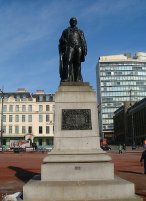 The anniversaries of Burns' birth and death have been marked annually by ceremonies at the Burns Monument in George Square since it was erected in 1877, during which floral tributes are laid and Burns' associations with Glasgow are recalled.
The anniversaries of Burns' birth and death have been marked annually by ceremonies at the Burns Monument in George Square since it was erected in 1877, during which floral tributes are laid and Burns' associations with Glasgow are recalled.
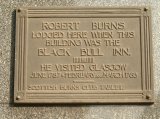 A plaque was later mounted on the fašade of the Black Bull Hotel to commemorate Burns' visits and was replaced by a new plaque after Marks & Spencer's store was built on the site (the plaque is on the Virginia Street wall), and one really ought to be placed on the site of the McLehose house.
A plaque was later mounted on the fašade of the Black Bull Hotel to commemorate Burns' visits and was replaced by a new plaque after Marks & Spencer's store was built on the site (the plaque is on the Virginia Street wall), and one really ought to be placed on the site of the McLehose house.
 Some years later, Mossman produced the full length statue of Burns which was included amongst the allegorical figures on the original fašade of the Citizens Theatre in the Gorbals, again representing Poetry. After the fašade was demolished in 1977, the statue, together with Shakespeare and the Muses, was placed in the foyer of the theatre in 1990, after being displayed at the Tron Theatre where Burns, appropriately, stood in the bar.
Some years later, Mossman produced the full length statue of Burns which was included amongst the allegorical figures on the original fašade of the Citizens Theatre in the Gorbals, again representing Poetry. After the fašade was demolished in 1977, the statue, together with Shakespeare and the Muses, was placed in the foyer of the theatre in 1990, after being displayed at the Tron Theatre where Burns, appropriately, stood in the bar.
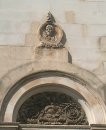 Less well known portraits include a tiny corbel head at the window of a private residence in Cleveden Road, where he is partnered with Shakespeare,
and which was carved in the early 1870s. Amongst the known portraits of Burns that have disappeared is the bust on the New Albion Halls, of 1876, which stood in Ingram Street until it was gutted by fire in 1909, when the bust and those of other artists were destroyed.
Less well known portraits include a tiny corbel head at the window of a private residence in Cleveden Road, where he is partnered with Shakespeare,
and which was carved in the early 1870s. Amongst the known portraits of Burns that have disappeared is the bust on the New Albion Halls, of 1876, which stood in Ingram Street until it was gutted by fire in 1909, when the bust and those of other artists were destroyed.
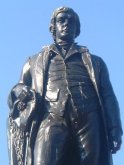 The most important Burns monument in Glasgow, however, is the bronze statue in George Square by
The most important Burns monument in Glasgow, however, is the bronze statue in George Square by 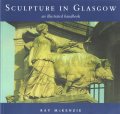 This handy paperback explores an aspect of Glasgow's fabric which, until recent years,
has largely been ignored by architectural historians and cultural commentators -
the wealth of sculpture that enriches its
streets and buildings. Beautifully illustrated, with colour photographs
throughout, and incorporating extensive original research, it reveals
the astounding scope and quality of the city's sculptural
heritage. It is a celebration of over four centuries of achievement, and
a journey through the city as it has rarely been seen before.
This handy paperback explores an aspect of Glasgow's fabric which, until recent years,
has largely been ignored by architectural historians and cultural commentators -
the wealth of sculpture that enriches its
streets and buildings. Beautifully illustrated, with colour photographs
throughout, and incorporating extensive original research, it reveals
the astounding scope and quality of the city's sculptural
heritage. It is a celebration of over four centuries of achievement, and
a journey through the city as it has rarely been seen before.
